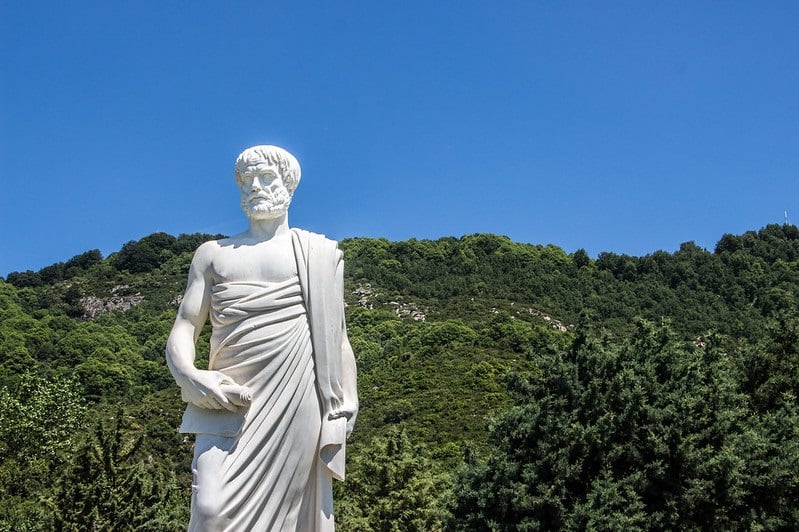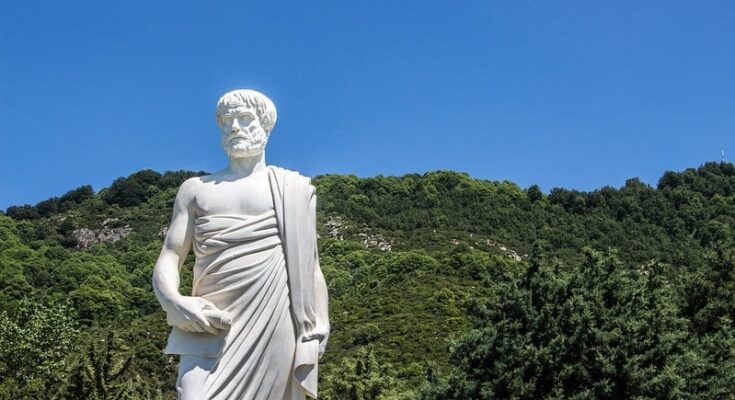
On the eastern coast of Halkidiki in Greece near the village of Olympiada lie the ruins of ancient Stagira. Though small and unassuming, this site boasts great historical importance as the birthplace of the great philosopher Aristotle.
Aristotle, born in 384 BC during Greece’s classical period, became one of the most influential philosophers of all time. His ideas shaped the sphere of philosophy from antiquity all the way through the Renaissance, and today they’re being studied with the same zeal.
Aristotle’s connection to ancient Stagira
The philosopher was born in the small city of Stagira, founded around 655 BC by Ionian settlers from the island of Andros. It is from this city that Aristotle earned the nickname “the Stagirite,” which is often used in texts in reference to him. He came from a distinguished family—his father, Nicomachus, was physician to King Amyntas of Macedon, and his mother, Phaestis, came from a wealthy family in Euboea.
At 17, Aristotle left Stagira to study at Plato’s famed Academy in Athens. However, in 348 BC, while he was away, King Philip II of Macedon, the father of Alexander the Great, conquered and destroyed the city. When Philip later asked Aristotle to tutor his son Alexander, it is said that Aristotle agreed on one condition: that Philip rebuild Stagira and restore its people. If this is true, it shows Aristotle’s deep attachment to his hometown and his concern for its future.
As a renowned philosopher of Athens, did Aristotle ever return to his homeland? It is possible. Historical records suggest that between 341 and 335 BC, Aristotle may have spent time in Stagira before eventually returning to Athens in 335 BC. There, he founded the Lyceum, his own school, named in honor of Apollo Lyceus, after a famous statue by Praxiteles.
Aristotle’s connection to ancient Stagira endured even past his death. After passing away in 322 BC in Chalkida, his remains were transferred to Stagira, where he was buried with honor. In recognition of his achievements, the people of Stagira declared him a “founder” of the city, as he was likely the reason for its rebuilding. They also built an altar over his tomb and established an annual festival in his name, the “Aristoteleia.” To this day, Aristotle’s name is inseparably tied to Stagira.
The landscape and architecture of ancient Stagira
As previously mentioned, Stagira is located on the eastern coast of Halkidiki, sitting on a peninsula near the seaside village of Olympiada. Just offshore is the small, uninhabited island of Kafkanas, known in Aristotle’s time as Capros, meaning “boar.” This island lent its name to Stagira’s harbor, while the boar likely was a significant symbol for the Stagirites, even appearing on their silver coins.

In the late 20th century, around 1960, excavations began that revealed significant portions of ancient Stagira, including its archaic walls and well-preserved early classical fortifications. These limestone and marble fortifications stretched for 2 kilometers and showcased various building techniques of the time. The city also had an acropolis which once protected its inhabitants. From its summit, visitors today can take in stunning views of the sea—perhaps standing on the very stones where Aristotle himself once stood.
Evidence also suggests that the people of Stagira were devoted in their worship. On the eastern edge of the city, the remains of a 6th-century BC sanctuary have been uncovered. The Stagirites honored mainly female deities in those spaces, and this particular sanctuary was likely dedicated to the goddess Demeter.
One of the most important remnants of ancient Stagira is the Agora, nestled between the two hills on which the city was built. Back in antiquity, the Agora served as both a political and commercial center, including a Stoa where citizens would gather to discuss public affairs and debate.
Beyond the Agora, archaeologists have uncovered fragments of houses and various artifacts, many of which are now housed in the Archaeological Museum of Polygyros, just an hour’s drive from Stagira. All these findings allow us, over 2000 years later, a glimpse into the daily life of Aristotle’s homeland at its peak.

The philosopher’s deep connection to ancient Stagira is apparent not only in his role in its rebuilding but also in its fate after his death. As years passed, Stagira slowly declined, eventually falling into desertion and abandonment.
Today, ancient Stagira is inseparably linked with Aristotle, and the town lives on largely through his memory. If you find yourself in Thessaloniki or Halkidiki, a visit to the city that helped shape one of history’s greatest philosophical minds is definitely worthwhile.



